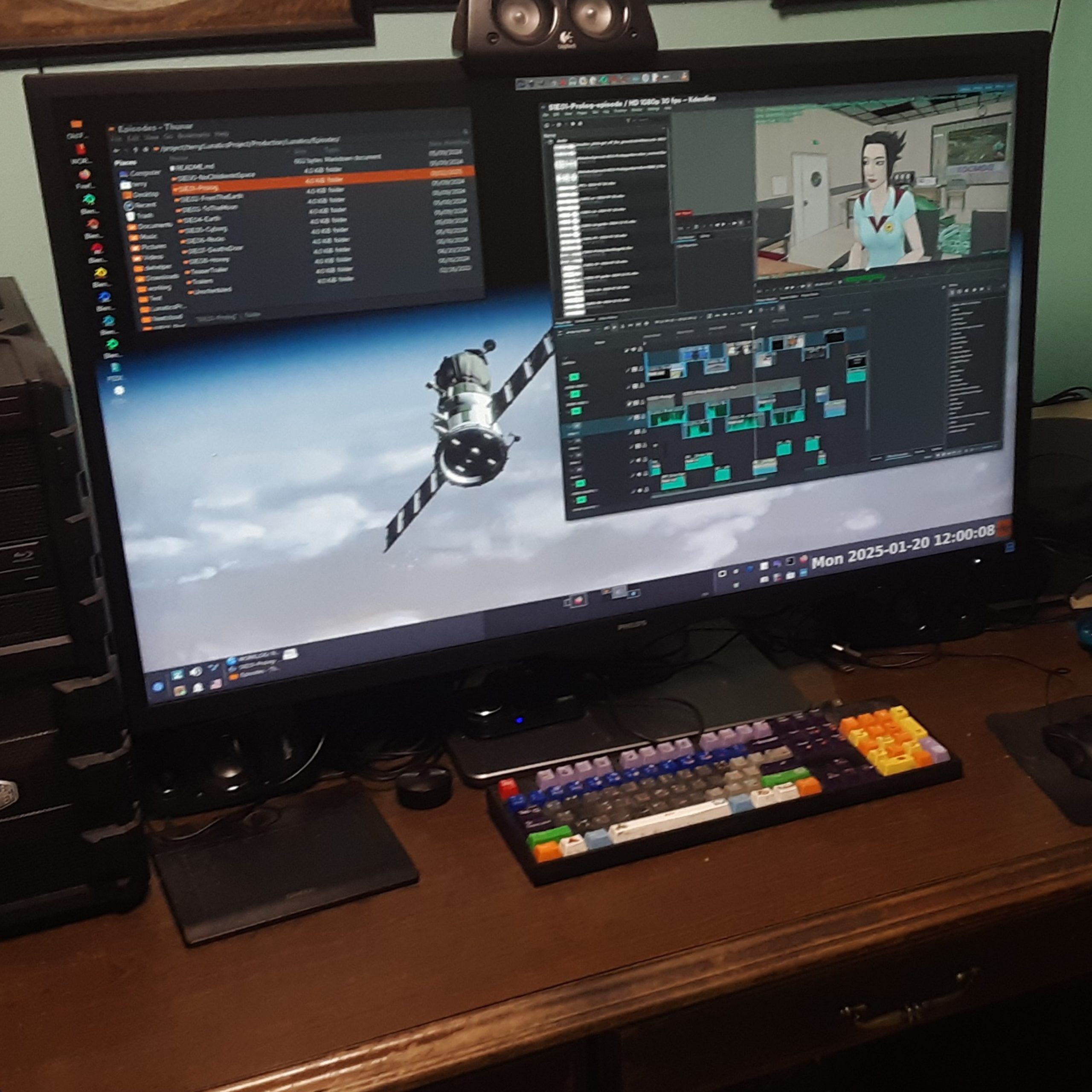Lunatics is being produced independently on a “free film” model — that is to say, we are using a free-culture license (Creative Commons Attribution-ShareAlike 4.0), and it will be mostly “open source” in that we will release as much of the source material as we are able to do.
It was conceived as a “commercial” project, in that the original plan was to earn enough from sales, subscriptions, crowdfunding, and ancillary sources to sustain it. This is an experiment in creating media sustainably without the theoretically-restrictive, but practically difficult-to-enforce charade of copyright “protection”, which invites authoritarian rule by protecting oligarchic corporate interests at the expense of individual artists, centralizing funds and control, and enabling mechanisms for censoring free expression.
Other projects have demonstrated some success in this area, and we’ve tried to learn from them:
- Morevna Project
- Tube Project / “Wires for Empathy”
- Blender Open Movies (“Sintel”, “Big Buck Bunny”, and “Elephants Dream”).
- Question Copyright / “Sita Sings the Blues”
Using free-licensed open-source software for that is a natural outcome of the desire to be able to collaborate with the community on the production (anyone can acquire the software tools to participate in our project). Major software packages involved in our production pipeline include:
- Blender (3D modeling, rendering, compositing, and animation) version 2.79 (last “Blender Internal” Renderer version).
- Kdenlive (Non-linear video and PNG-stream editing, some compositing).
- Audacity (Audio editing)
- Inkscape (Vector graphics)
- Gimp (Bitmap graphics and photo manipulation)
- Krita (Digital painting, adopted since 2019)
- MyPaint (Digital painting, pre-2019)
- Papagayo NG (Lipsync timing tool)
- Ardour (Non-destructive audio mixing)
Please see our Software Tools page for more detail.
Using a copylefted free-license for our release means we also can use similarly-licensed elements to help in our production. Between this and the low cost of using free/open-source software for production means that our overall cost can be very low, and mostly in the form of time from contributors.
Our hope is that this will make it feasible to fund the project using free-culture-compatible sources that don’t require us to rely on a copyright monopoly, such as:
- Pre-Production Crowd-funding
- Post-Production Pre-Sales
- Post-Release Creator-Endorsed Sales
- Subscriptions & Donations
- Ancillary Sales
- Advertising
Format
The series is structured essentially on the model of “anime” series, with short episodes and multi-episode arcs, but without a rigid adherence to episode length, since an internet-release approach doesn’t require it. Our plans for this have changed significantly since originally conceived in 2011, and they may have to change again.
In Production
As of January 2025, we have a total of four episodes in various stages of production:
No Children in Space (Pilot: 18 min)
Finishing stages: there is still some rework animation I want to complete before release, but we have released a version of the episode to our Patreon supporters. Public release is planned for April 12th, 2025 — “Yuri’s Night”. This episode is pretty short, as it was originally conceived as an animation demo, so as release, it will include a promotional for the DVD/Download Package releases, which will include a lot of behind-the-scenes content, production source files, and so on. This extends it to a 23 min video.
From the Earth… (~20 min)
Dialog recorded. Storyboards and storyreel exist as part of our original one-hour pilot concept, and simply need to be adapted to the 3-episode format we’ve settled on. We have most of the 3D assets, with a few interior sets and characters remaining to create. Animation has not yet begun (except for a few mech animation tests).
…To the Moon (~25 min)
Dialog recorded. Storyboards and storyreel, also from our original one-hour pilot concept. We have a few of the 3D assets for this one, but many need to be created, including the sets for the ISF-1 lunar settlement. No animation (beyond a few tests).
Earth (~35 min)
Dialog recorded. We produced an audiodrama version of this episode from the recordings, but have not yet planned animation or developed important assets, such as Emerson’s robot “intelligent artworks”.
In Development
Additional “series 1” episodes have been in development, but we don’t want to exert too much energy into them until the above “in production” episodes are completed:
- Cyborg (Not exactly a literal cyborg)
- Rocks (There’s geology in this one!)
- Death’s Door (About what you think, but not how you think it)
- Oh Honey! (Let’s just say there are bees involved)
- Field Trip (What it says on the label, but gone horribly, horribly wrong)
- Moon Day (Patriotic-ish..?)
- Evacuation (Something like that, anyway)
These have treatments, but not scripts, except for a few snippets. Only Rosalyn and Terry know these stories — so far.
In 2012, we had very ambitious plans to move forward with a faster production schedule that would have required us to be a lot more successful financially than has actually happened. That “Fast Plan” did not pan out, so we have instead been moving forward the slow way, with almost-pure volunteer contributions. Since about 2019, the production team is really just (director) Terry Hancock trying to finish up what we have.
So, as things stand, we’re not putting effort into these “in development” stories until we have completed more of the “in production” work. The hope is that we can build up some buzz, get some subscribers, recruit some contributors (either woo back the ones who worked with us before or find new ones), and then get back into active production. This probably will not happen without some sort of funding, which presumably will be based on the popularity of the existing episodes.
The series will follow a “braided” narrative, with each of the principle characters becoming the protagonist for certain episodes, while others act as supporting characters. Occasionally we will have an “ensemble” episode in which all of their storylines are balanced.
Virtual Studio
In about 2015, after we took on two student interns, I became aware that the lack of any real “Studio Infrastructure” was holding us back, and so from 2016 to 2023, I spent a great deal of time on what I have come to refer to as our “Virtual Studio”.
This concept has evolved substantially, but currently refers to a suite of off-the-shelf open-source web application software which is partially deployed on a Digital Ocean “Droplet” VPS. The primary components include:
- WordPress (Production Log / CMS).
- Nextcloud (Source Files & Office Documents — currently non-working, due to disk space limitations on the VPS).
- PeerTube (Federated video publishing).
- Gitea (Software “Forge” for our scripts, extensions, and other utilities).
- Pixelfed (Project PR Fediverse Account).
- Misskey (Terry Hancock‘s Director/Producer Fediverse Account)
We are facing some serious problems with the limitations of the VPS, particularly for Lunatics Project source files, which are really too large for the available options with the VPS. We’ve tried remote object storage, but the latency this introduces makes it unworkable. Our plan for some time now has been to move the site to a co-located dedicated server, though that too, has technically challenges we still need to overcome (mainly the learning curve for aspects of the networking I have not had to learn before).
The proposed new system will introduce a few minor changes:
- Nextcloud should work directly off of a local disk.
- Gitea will be replaced by Forgejo (a community fork).
And we’ll add some additional services:
We are still evaluating options for teleconferencing, videoconferencing, whiteboard, and other tools we might want on the new site.
Production Team
Project founded and conceived by Rosalyn Hunter (Writer) and Terry Hancock (Producer/Director). Characters were designed by Daniel Fu.
2017 Modeling & Animation Team: Chris Kuhn, Keneisha Perry, Terry Hancock.
Past Modeling & Animation Team: Andrew Pray, Cosmin Planchon, Gorka Mendieta, Guillaume Cote, Vyacheslav Yastrebcev, Timothee Giet, Sathish Kumar, Bela Szabo.
Sound Team: (Not currently active — most sound design work so far was done by Terry Hancock).
Voices: William Roberts (Rob), Karrie Shirou (Hiromi), Veronika Kurshinskaya (Anya), Paul Birchard (Josh, Allen), Lex Quarterman (Tim), Ariel Hancock (Georgiana), Melodee M. Spevack (Narrator), Sergei Oleinik (Sergei), Kristina Ponomarenko, Miki Kuroki, Jami Cullen, Karen Jagger, Sophie LeNeveu, David Jordan, Sylvan Hancock, Nicholas Hancock, Janet Hancock, Terry Hancock, Rosalyn Hunter, Nadezhda Dmitriev, Shamil Aminov.
(See Episodes for Additional Credits)
The Future?
I honestly don’t know if this will work — whether we can make enough money on the goodwill of fans to sustain the project or justify the thousands of hours of effort it will require from dozens of people to see it through. And therefore, I don’t know how long we’ll be able to keep it up. At least we will try very hard to complete the pilot. Hopefully, we’ll get enough interest to see us through a season. If things work out well, we have excellent story arcs planned all the way through to a third season, and some ideas for beyond that. But that really depends on your support, and that unquestionably depends on how well we do our job. In any case, I’m pretty sure it’s going to be fun!

